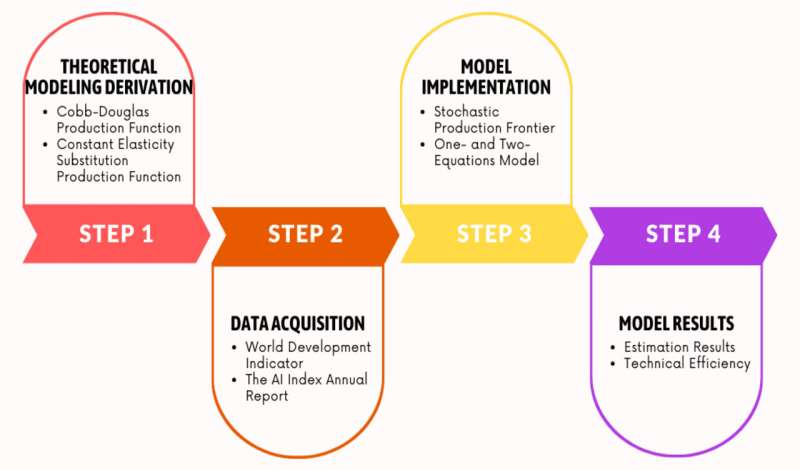
Countries that invest in artificial intelligence see a significant impact on their productivity and growth, but they should take a strategic approach, according to new University at Buffalo School of Management research.
Published in Decision Analytics Journal, the study found that AI innovation (as measured by the number of AI-related patents and capital investment) works best with the presence of a highly skilled labor force and the proper internet infrastructure to harness its full potential.
“AI innovation has the potential to transform economies, but our study shows that more patents and investments do not automatically translate into higher production efficiency,” says co-author Raj Sharman, Ph.D., professor of management science and systems in the UB School of Management. “A strategic approach that includes high-speed internet access and skilled labor is key to realizing AI’s full benefits.”
To study the impact of AI innovation, the researchers analyzed data for AI patents, capital and labor from 10 countries over an 11-year period. They used the stochastic production frontier model, employing both the Cobb-Douglas function and the Constant Elastic Substitution model, to evaluate the relationship between traditional economic inputs, such as capital and labor, and AI inputs to determine production efficiency.
The researchers found that while the U.S. leads in AI innovation with the highest number of patents, the U.K. has the highest production efficiency. Meanwhile, China ranks fourth in AI innovation, but has the lowest production efficiency among the countries studied.
“The U.S., with its long history and vast resources in AI research, does not show the best efficiency,” says Sharman. “The U.K. has performed better despite its lower investment in AI because they’ve used their resources better and have more effectively integrated AI into their work.”
Looking ahead, the researchers say that countries and businesses need to shift their focus from just increasing AI innovation to improving how efficiently they implement and use the technology. This means investing in internet bandwidth, upskilling the workforce and strategically optimizing resources to achieve the best results.
More information:
Ying-Chih Sun et al, A stochastic production frontier model for evaluating the performance efficiency of artificial intelligence investment worldwide, Decision Analytics Journal (2024). DOI: 10.1016/j.dajour.2024.100504
University at Buffalo
Study shows that AI investment plus a connected, skilled workforce is a winning combination (2024, September 24)
retrieved 26 September 2024
from https://techxplore.com/news/2024-09-ai-investment-skilled-workforce-combination.html
part may be reproduced without the written permission. The content is provided for information purposes only.

Countries that invest in artificial intelligence see a significant impact on their productivity and growth, but they should take a strategic approach, according to new University at Buffalo School of Management research.
Published in Decision Analytics Journal, the study found that AI innovation (as measured by the number of AI-related patents and capital investment) works best with the presence of a highly skilled labor force and the proper internet infrastructure to harness its full potential.
“AI innovation has the potential to transform economies, but our study shows that more patents and investments do not automatically translate into higher production efficiency,” says co-author Raj Sharman, Ph.D., professor of management science and systems in the UB School of Management. “A strategic approach that includes high-speed internet access and skilled labor is key to realizing AI’s full benefits.”
To study the impact of AI innovation, the researchers analyzed data for AI patents, capital and labor from 10 countries over an 11-year period. They used the stochastic production frontier model, employing both the Cobb-Douglas function and the Constant Elastic Substitution model, to evaluate the relationship between traditional economic inputs, such as capital and labor, and AI inputs to determine production efficiency.
The researchers found that while the U.S. leads in AI innovation with the highest number of patents, the U.K. has the highest production efficiency. Meanwhile, China ranks fourth in AI innovation, but has the lowest production efficiency among the countries studied.
“The U.S., with its long history and vast resources in AI research, does not show the best efficiency,” says Sharman. “The U.K. has performed better despite its lower investment in AI because they’ve used their resources better and have more effectively integrated AI into their work.”
Looking ahead, the researchers say that countries and businesses need to shift their focus from just increasing AI innovation to improving how efficiently they implement and use the technology. This means investing in internet bandwidth, upskilling the workforce and strategically optimizing resources to achieve the best results.
More information:
Ying-Chih Sun et al, A stochastic production frontier model for evaluating the performance efficiency of artificial intelligence investment worldwide, Decision Analytics Journal (2024). DOI: 10.1016/j.dajour.2024.100504
University at Buffalo
Study shows that AI investment plus a connected, skilled workforce is a winning combination (2024, September 24)
retrieved 26 September 2024
from https://techxplore.com/news/2024-09-ai-investment-skilled-workforce-combination.html
part may be reproduced without the written permission. The content is provided for information purposes only.








